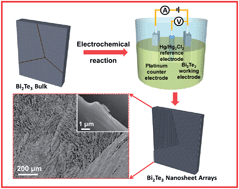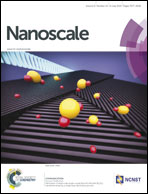Fabrication of large-scale single-crystal bismuth telluride (Bi2Te3) nanosheet arrays by a single-step electrolysis process†
Abstract
Nanolizing of thermoelectric materials is one approach to reduce the thermal conductivity and hence enhance the figure of merit. Bismuth telluride (Bi2Te3)-based materials have excellent figure of merit at room temperature. For device applications, precise control and rapid fabrication for the nanostructure of thermoelectric materials are essential issues. In the present study, we demonstrate a one-step electrolysis process to directly form Bi2Te3 nanosheet arrays (NSAs) on the surface of bulk Bi2Te3 with controllable spacing distance and depth by tuning the applied bias and duration. The single sheet of NSAs reveals that the average thickness and electrical resistivity of single crystalline Bi2Te3 in composition are 399.8 nm and 137.34 μΩ m, respectively. The formation mechanism of NSAs has been proposed. A 1.12% efficiency of quantum dot-sensitized solar cells with Bi2Te3 NSAs for counter electrode has been demonstrated, indicating that Bi2Te3 NSAs from top-down processing with a high ratio of surface area to volume are a promising candidate for possible applications such as thermoelectrics, dye-sensitized solar cells (DSSCs), and lithium-ion batteries.


 Please wait while we load your content...
Please wait while we load your content...